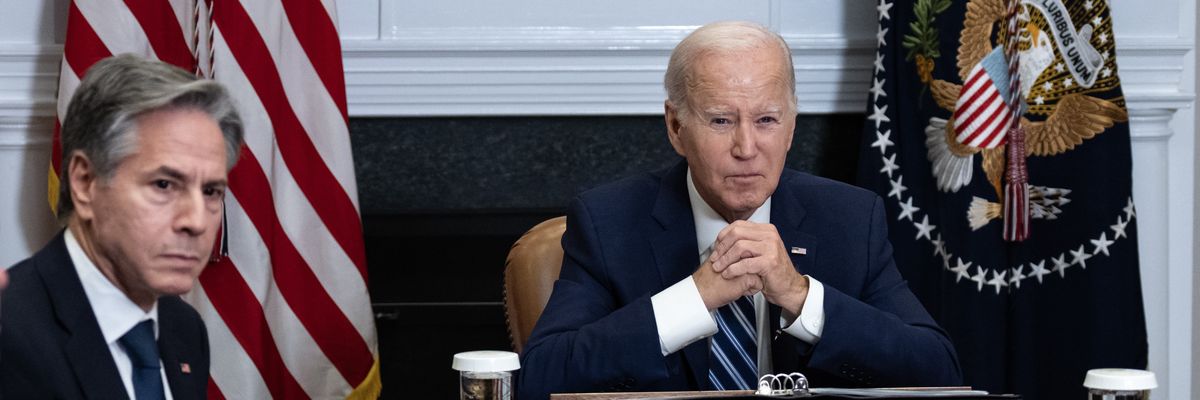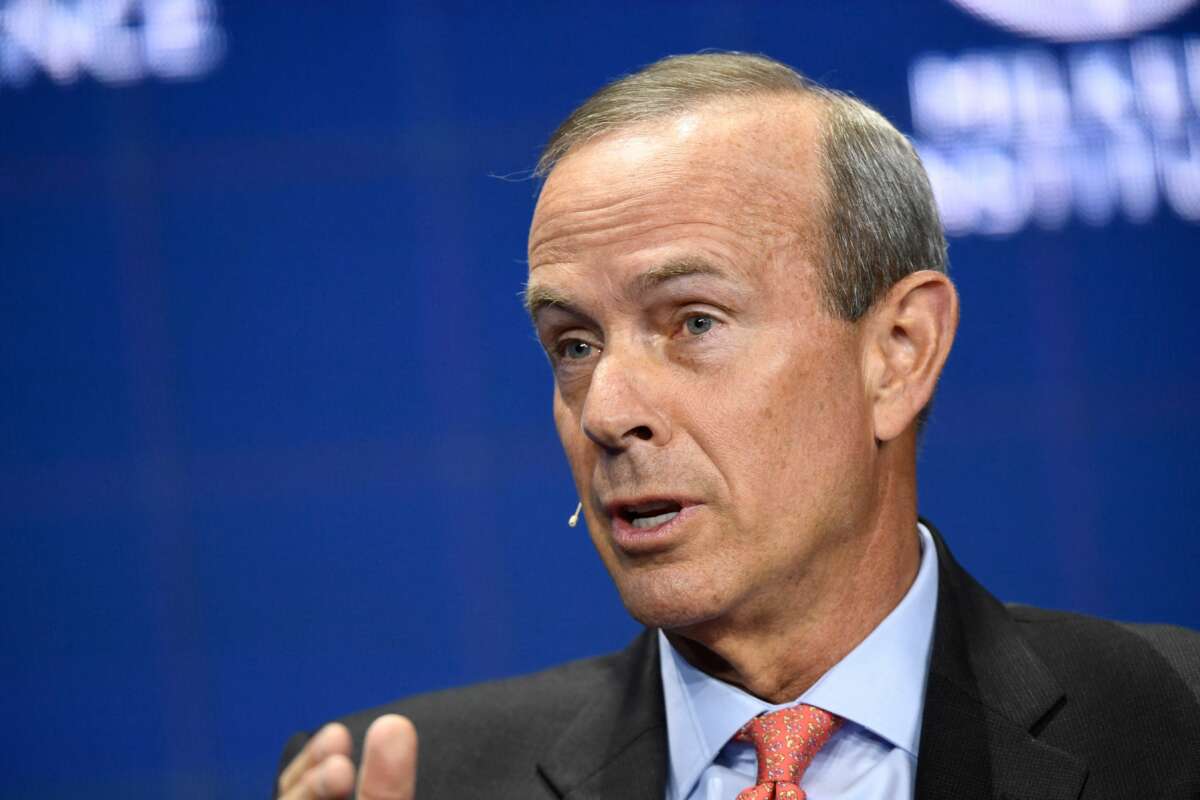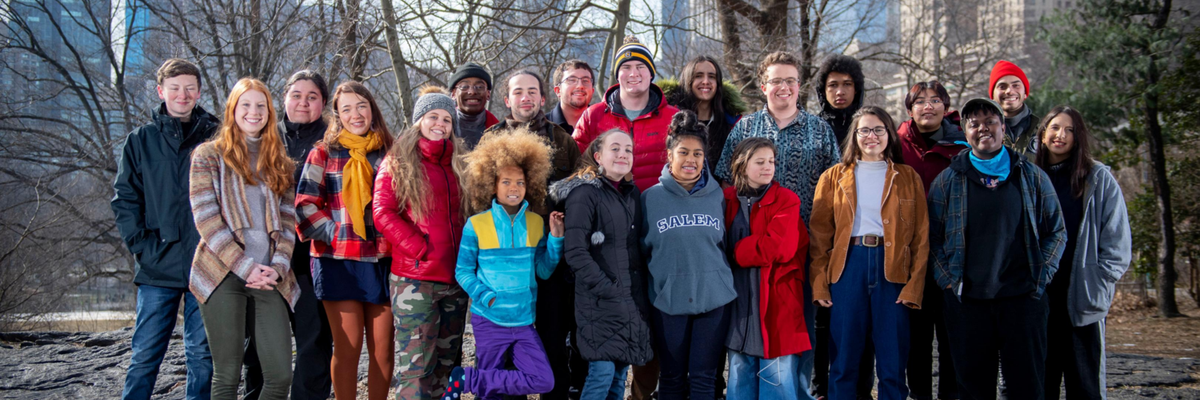By Juan Cole
February 2, 2024
Source: Informed Comment

Federal Building, Oakland, CA on Jan. 26, 2024 — Crowds gather to listen to speakers and performers while they wait for plaintiffs and lawyers to exit the courthouse following their time pleading their case before a federal judge
U.S. District Judge Jeffrey S. White of the Northern District of California ruled Tuesday in a lawsuit brought by Palestinian-Americans and the Palestinian human rights group al-Haq against President Joe Biden, Secretary of Defense Lloyd Austin and Secretary of State Antony Blinken for their involvement in an Israeli genocide against the Palestinians of Gaza. White found that the suit had merit on the facts but that a district court could not overrule the president of the United States on foreign policy. That is, the conclusion of the case was more about the separation of powers than about whether the Biden administration is guilty of participating in a genocide.
The judge felt he had to dismiss the case, given a whole plethora of previous Supreme Court decisions. He clearly did so, however, with enormous regret.
White seems to be calling for mass political action by Americans on the issue. He asserted that “It is every individual’s obligation to confront the current siege in Gaza.” He went on to lament, however, “but it also this Court’s obligation to remain within the metes and bounds of its jurisdictional scope.”
He wrote in his conclusion,
“There are rare cases in which the preferred outcome is inaccessible to the Court. This is one of those cases. The Court is bound by precedent and the division of our coordinate branches of government to abstain from exercising jurisdiction in this matter. Yet, as the ICJ has found, it is plausible that Israel’s conduct amounts to genocide. This Court implores Defendants to examine the results of their unflagging support of the military siege against the Palestinians in Gaza.”
Here is a federal judge pleading with the president of the United States, the secretary of state, and the secretary of defense to cease their unstinting support for Israeli military tactics in Gaza that are so extensively harming the lives of Palestinian civilians in Gaza.
White wrote, “On November 13, 2023, Plaintiffs filed this suit against the Defendants to “take all measures within their power to prevent Israel’s commission of genocidal acts against the Palestinian people of Gaza.” (Compl., Prayer for Relief.) Plaintiffs allege that Defendants violate their duties under Article I of the Genocide Convention by supporting Israel’s military actions following the attacks of October 7, 2023.” They asked the court to issue a preliminary injunction against the Biden administration from further participating in and aiding these genocidal acts.
The idea is that the US is a signatory to the Genocide Convention of 1948, which makes it US law, so that Biden and his cabinet secretaries are violating not just international law but American domestic law.
White noted that the International Court of Justice recently found that the charges of genocide against Israel are plausible, given the wholesale destruction of civilian life and property and given the public statements of intent voiced by Israeli leaders.
In the British and American tradition of common law, precedent can be cited from abroad, so it is legitimate for White to instance the ICJ preliminary order that Israel cease behaving in ways that can plausibly construed as genocidal.
White quoted the ICJ preliminary decision at length in his own ruling, saying, “The ICJ found that:
‘the military operation being conducted by Israel following the attack of 7 October 2023 has resulted in a large number of deaths and injuries, as well as the massive destruction of homes, forcible displacement of the vast majority of the population, and extensive damage to civilian infrastructure. While figures relating to the Gaza Strip cannot be independently verified, recent information indicates that 25,700 Palestinians have been killed, over 63,000 injuries have been reported, over 360,000 housing units have been destroyed or partially damaged and approximately 1.7 million persons have been internally displaced.’”
He further noted that “the International Court found that it considered it “plausible [that the] rights in question in these proceedings, namely the right of Palestinians in the Gaza Strip to be protected from acts of genocide and related prohibited acts identified in Article III of the Genocide Convention, … are of such a nature that prejudice to them is capable of causing irreparable harm.”
For a court case to go forward, certain basic criteria have to be met. Do the plaintiffs have standing? White appears to have accepted that they did. That is, real harm was being inflicted on the families of these Palestinian-Americans from the Gaza Strip. Is there firm evidence of a crime being committed? White says that there clearly is, and he joins his voice to that of the ICJ here. Has the action been brought in an appropriate venue? And here the case failed, not on its merits, but over this jurisdictional issue.
The problem with this case, White held, is that it concerns political policy, and the Supreme Court has a long history of holding that courts cannot interfere with executive decision-making in the purely political realm. Moreover, foreign policy is a primary example of executive decision-making of a political sort in which courts have typically declined to intervene. So the separation of powers between the judiciary and the executive disallows White from telling Biden what he can do in the political realm, especially in the area of foreign policy.
White writes, “Foreign policy is constitutionally committed to the political branches of government, and disputes over foreign policy are considered nonjusticiable political questions. See, e.g., Haig v. Agee, 453 U.S. 280, 292 (1981) (“[T]he conduct of foreign relations … [is] exclusively entrusted to the political branches … [and] immune from judicial inquiry or interference.”). “The President is the sole organ of the nation in its external relations, and its sole representative with foreign nations.” United States v. Curtiss-Wright Exp. Corp., 299 U.S. 304, 319 (1936.”
He noted that not only does the president have wide latitude in foreign policy that cannot be easily challenged in the courts, but that the policy of unstinting support for Israel’s actions is also rooted in Congressional legislation. So where can this action be brought, since it is so clearly meritorious in the judge’s eyes?
In asserting that “It is every individual’s obligation to confront the current siege in Gaza,” White seemed to be calling for mass political action by the people. It is a remarkable appeal for a federal judge. He recognizes that we won’t get justice on this issue from Biden or from Congress. If things are to change, all Americans must confront this genocide in the legal ways available to them.
ZNetwork is funded solely through the generosity of its readers.DONATE

Juan Cole is Richard P. Mitchell Collegiate Professor of History at the University of Michigan. For three and a half decades, he has sought to put the relationship of the West and the Muslim world in historical context, and he has written widely about Egypt, Iran, Iraq, and South Asia. His books include Muhammad: Prophet of Peace Amid the Clash of Empires; The New Arabs: How the Millennial Generation is Changing the Middle East; Engaging the Muslim World; and Napoleon’s Egypt: Invading the Middle East.

Federal Building, Oakland, CA on Jan. 26, 2024 — Crowds gather to listen to speakers and performers while they wait for plaintiffs and lawyers to exit the courthouse following their time pleading their case before a federal judge
U.S. District Judge Jeffrey S. White of the Northern District of California ruled Tuesday in a lawsuit brought by Palestinian-Americans and the Palestinian human rights group al-Haq against President Joe Biden, Secretary of Defense Lloyd Austin and Secretary of State Antony Blinken for their involvement in an Israeli genocide against the Palestinians of Gaza. White found that the suit had merit on the facts but that a district court could not overrule the president of the United States on foreign policy. That is, the conclusion of the case was more about the separation of powers than about whether the Biden administration is guilty of participating in a genocide.
The judge felt he had to dismiss the case, given a whole plethora of previous Supreme Court decisions. He clearly did so, however, with enormous regret.
White seems to be calling for mass political action by Americans on the issue. He asserted that “It is every individual’s obligation to confront the current siege in Gaza.” He went on to lament, however, “but it also this Court’s obligation to remain within the metes and bounds of its jurisdictional scope.”
He wrote in his conclusion,
“There are rare cases in which the preferred outcome is inaccessible to the Court. This is one of those cases. The Court is bound by precedent and the division of our coordinate branches of government to abstain from exercising jurisdiction in this matter. Yet, as the ICJ has found, it is plausible that Israel’s conduct amounts to genocide. This Court implores Defendants to examine the results of their unflagging support of the military siege against the Palestinians in Gaza.”
Here is a federal judge pleading with the president of the United States, the secretary of state, and the secretary of defense to cease their unstinting support for Israeli military tactics in Gaza that are so extensively harming the lives of Palestinian civilians in Gaza.
White wrote, “On November 13, 2023, Plaintiffs filed this suit against the Defendants to “take all measures within their power to prevent Israel’s commission of genocidal acts against the Palestinian people of Gaza.” (Compl., Prayer for Relief.) Plaintiffs allege that Defendants violate their duties under Article I of the Genocide Convention by supporting Israel’s military actions following the attacks of October 7, 2023.” They asked the court to issue a preliminary injunction against the Biden administration from further participating in and aiding these genocidal acts.
The idea is that the US is a signatory to the Genocide Convention of 1948, which makes it US law, so that Biden and his cabinet secretaries are violating not just international law but American domestic law.
White noted that the International Court of Justice recently found that the charges of genocide against Israel are plausible, given the wholesale destruction of civilian life and property and given the public statements of intent voiced by Israeli leaders.
In the British and American tradition of common law, precedent can be cited from abroad, so it is legitimate for White to instance the ICJ preliminary order that Israel cease behaving in ways that can plausibly construed as genocidal.
White quoted the ICJ preliminary decision at length in his own ruling, saying, “The ICJ found that:
‘the military operation being conducted by Israel following the attack of 7 October 2023 has resulted in a large number of deaths and injuries, as well as the massive destruction of homes, forcible displacement of the vast majority of the population, and extensive damage to civilian infrastructure. While figures relating to the Gaza Strip cannot be independently verified, recent information indicates that 25,700 Palestinians have been killed, over 63,000 injuries have been reported, over 360,000 housing units have been destroyed or partially damaged and approximately 1.7 million persons have been internally displaced.’”
He further noted that “the International Court found that it considered it “plausible [that the] rights in question in these proceedings, namely the right of Palestinians in the Gaza Strip to be protected from acts of genocide and related prohibited acts identified in Article III of the Genocide Convention, … are of such a nature that prejudice to them is capable of causing irreparable harm.”
For a court case to go forward, certain basic criteria have to be met. Do the plaintiffs have standing? White appears to have accepted that they did. That is, real harm was being inflicted on the families of these Palestinian-Americans from the Gaza Strip. Is there firm evidence of a crime being committed? White says that there clearly is, and he joins his voice to that of the ICJ here. Has the action been brought in an appropriate venue? And here the case failed, not on its merits, but over this jurisdictional issue.
The problem with this case, White held, is that it concerns political policy, and the Supreme Court has a long history of holding that courts cannot interfere with executive decision-making in the purely political realm. Moreover, foreign policy is a primary example of executive decision-making of a political sort in which courts have typically declined to intervene. So the separation of powers between the judiciary and the executive disallows White from telling Biden what he can do in the political realm, especially in the area of foreign policy.
White writes, “Foreign policy is constitutionally committed to the political branches of government, and disputes over foreign policy are considered nonjusticiable political questions. See, e.g., Haig v. Agee, 453 U.S. 280, 292 (1981) (“[T]he conduct of foreign relations … [is] exclusively entrusted to the political branches … [and] immune from judicial inquiry or interference.”). “The President is the sole organ of the nation in its external relations, and its sole representative with foreign nations.” United States v. Curtiss-Wright Exp. Corp., 299 U.S. 304, 319 (1936.”
He noted that not only does the president have wide latitude in foreign policy that cannot be easily challenged in the courts, but that the policy of unstinting support for Israel’s actions is also rooted in Congressional legislation. So where can this action be brought, since it is so clearly meritorious in the judge’s eyes?
In asserting that “It is every individual’s obligation to confront the current siege in Gaza,” White seemed to be calling for mass political action by the people. It is a remarkable appeal for a federal judge. He recognizes that we won’t get justice on this issue from Biden or from Congress. If things are to change, all Americans must confront this genocide in the legal ways available to them.
ZNetwork is funded solely through the generosity of its readers.DONATE
Juan Cole is Richard P. Mitchell Collegiate Professor of History at the University of Michigan. For three and a half decades, he has sought to put the relationship of the West and the Muslim world in historical context, and he has written widely about Egypt, Iran, Iraq, and South Asia. His books include Muhammad: Prophet of Peace Amid the Clash of Empires; The New Arabs: How the Millennial Generation is Changing the Middle East; Engaging the Muslim World; and Napoleon’s Egypt: Invading the Middle East.
Judge Rejects US Complicity Case, But Urges Biden to Examine 'Unflagging' Support for Israel
An attorney for the group representing the plaintiffs said it is "unprecedented and damning that a federal court has all but affirmed that Israel is committing a genocide" with U.S. support.

U.S. Secretary of State Antony Blinken looks on as U.S. President Joe Biden speaks during a meeting in the Roosevelt Room of the White House
(Photo: Drew Angerer/Getty Images)
JAKE JOHNSON
Feb 01, 2024
COMMON DREAMS
A federal judge in Oakland, California dismissed a lawsuit Wednesday that aimed to stop the U.S. from aiding Israel's catastrophic assault on the Gaza Strip—but also offered sharp criticism of the Biden administration's unwavering support for the war.
U.S. Judge Jeffrey White of the Northern District of California ruled that the suit brought by Palestinian rights organizations and individuals in both the U.S. and Gaza falls "outside the court's limited jurisdiction" and must be rejected on technical grounds.
White described the case as a rare instance "in which the preferred outcome is inaccessible to the court," but notably pointed to the International Court of Justice's finding that South Africa's genocide case against Israel is "plausible" and suggested the U.S. government should reconsider its role in supporting the assault on Gaza.
"Both the uncontroverted testimony of the plaintiffs and the expert opinion proffered at the hearing on these motions as well as statements made by various officers of the Israeli government indicate that the ongoing military siege in Gaza is intended to eradicate a whole people and therefore plausibly falls within the international prohibition against genocide," White wrote.
"It is every individual's obligation to confront the current siege in Gaza, but it also this court's obligation to remain within the metes and bounds of its jurisdictional scope," he continued. "This court implores defendants to examine the results of their unflagging support of the military siege against the Palestinians in Gaza."
"We are still devastated that the court would not take the important step to stop the Biden administration from continuing to support the slaughter of the Palestinian people."
The ruling came as the estimated death toll from Israel's assault on Gaza passed 27,000—likely a dramatic undercount, given the number of bodies believed to be trapped under rubble and the growing difficulty of counting the dead as the Israeli bombing campaign nears the four-month mark.
Diala Shamas, senior staff attorney at the Center for Constitutional Rights (CCR)—which represented the plaintiffs in Defense for Children International – Palestine v. Biden—said in a statement Wednesday that the federal court's ruling was "far from a win for the U.S. government."
President Joe Biden, U.S. Secretary of State Antony Blinken, and Pentagon Secretary Lloyd Austin were named as defendants in the lawsuit, which sought an emergency order halting U.S. support for Israel's assault on Gaza. In its response to the lawsuit, the Biden administration argued for the case's dismissal on procedural grounds.
"It is unprecedented and damning that a federal court has all but affirmed that Israel is committing a genocide while criticizing defendants Biden, Blinken, and Austin's 'unflagging' support for the acts that constitute that genocide," said Shamas.
During oral arguments last week, Palestinian plaintiffs testified to the appalling destruction that Israel is imposing on Gaza's population, most of which is now displaced and at growing risk of starvation and disease. More than 100 of the plaintiffs' family members have been killed by Israeli attacks in Gaza since October 7, when the bombing began following a deadly Hamas-led assault on southern Israel.
"I have lost everything in this war," said Dr. Omar Al-Najjar, who testified from a Gaza hospital. "I have nothing but my grief. This is what Israel and its supporters have done to us."
Mohammed Monadel Herzallah, another plaintiff in the case, said in response to Wednesday's ruling that "it is important that the court recognized the United States is providing unconditional support to Israel's ongoing genocide in Gaza and that a federal court heard Palestinian voices for the first time."
"But we are still devastated that the court would not take the important step to stop the Biden administration from continuing to support the slaughter of the Palestinian people," said Herzallah. "Currently, my family lacks food, medicine, and the most basic necessities for survival. As Palestinians, we know this is a hard struggle, and as plaintiffs we will continue to do everything in our power to save our people's lives."
An attorney for the group representing the plaintiffs said it is "unprecedented and damning that a federal court has all but affirmed that Israel is committing a genocide" with U.S. support.

U.S. Secretary of State Antony Blinken looks on as U.S. President Joe Biden speaks during a meeting in the Roosevelt Room of the White House
(Photo: Drew Angerer/Getty Images)
JAKE JOHNSON
Feb 01, 2024
COMMON DREAMS
A federal judge in Oakland, California dismissed a lawsuit Wednesday that aimed to stop the U.S. from aiding Israel's catastrophic assault on the Gaza Strip—but also offered sharp criticism of the Biden administration's unwavering support for the war.
U.S. Judge Jeffrey White of the Northern District of California ruled that the suit brought by Palestinian rights organizations and individuals in both the U.S. and Gaza falls "outside the court's limited jurisdiction" and must be rejected on technical grounds.
White described the case as a rare instance "in which the preferred outcome is inaccessible to the court," but notably pointed to the International Court of Justice's finding that South Africa's genocide case against Israel is "plausible" and suggested the U.S. government should reconsider its role in supporting the assault on Gaza.
"Both the uncontroverted testimony of the plaintiffs and the expert opinion proffered at the hearing on these motions as well as statements made by various officers of the Israeli government indicate that the ongoing military siege in Gaza is intended to eradicate a whole people and therefore plausibly falls within the international prohibition against genocide," White wrote.
"It is every individual's obligation to confront the current siege in Gaza, but it also this court's obligation to remain within the metes and bounds of its jurisdictional scope," he continued. "This court implores defendants to examine the results of their unflagging support of the military siege against the Palestinians in Gaza."
"We are still devastated that the court would not take the important step to stop the Biden administration from continuing to support the slaughter of the Palestinian people."
The ruling came as the estimated death toll from Israel's assault on Gaza passed 27,000—likely a dramatic undercount, given the number of bodies believed to be trapped under rubble and the growing difficulty of counting the dead as the Israeli bombing campaign nears the four-month mark.
Diala Shamas, senior staff attorney at the Center for Constitutional Rights (CCR)—which represented the plaintiffs in Defense for Children International – Palestine v. Biden—said in a statement Wednesday that the federal court's ruling was "far from a win for the U.S. government."
President Joe Biden, U.S. Secretary of State Antony Blinken, and Pentagon Secretary Lloyd Austin were named as defendants in the lawsuit, which sought an emergency order halting U.S. support for Israel's assault on Gaza. In its response to the lawsuit, the Biden administration argued for the case's dismissal on procedural grounds.
"It is unprecedented and damning that a federal court has all but affirmed that Israel is committing a genocide while criticizing defendants Biden, Blinken, and Austin's 'unflagging' support for the acts that constitute that genocide," said Shamas.
During oral arguments last week, Palestinian plaintiffs testified to the appalling destruction that Israel is imposing on Gaza's population, most of which is now displaced and at growing risk of starvation and disease. More than 100 of the plaintiffs' family members have been killed by Israeli attacks in Gaza since October 7, when the bombing began following a deadly Hamas-led assault on southern Israel.
"I have lost everything in this war," said Dr. Omar Al-Najjar, who testified from a Gaza hospital. "I have nothing but my grief. This is what Israel and its supporters have done to us."
Mohammed Monadel Herzallah, another plaintiff in the case, said in response to Wednesday's ruling that "it is important that the court recognized the United States is providing unconditional support to Israel's ongoing genocide in Gaza and that a federal court heard Palestinian voices for the first time."
"But we are still devastated that the court would not take the important step to stop the Biden administration from continuing to support the slaughter of the Palestinian people," said Herzallah. "Currently, my family lacks food, medicine, and the most basic necessities for survival. As Palestinians, we know this is a hard struggle, and as plaintiffs we will continue to do everything in our power to save our people's lives."










